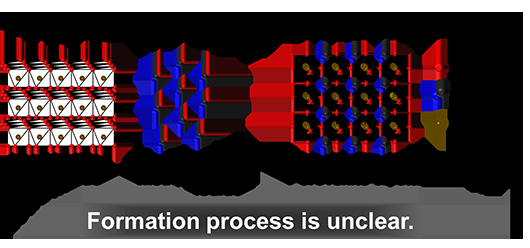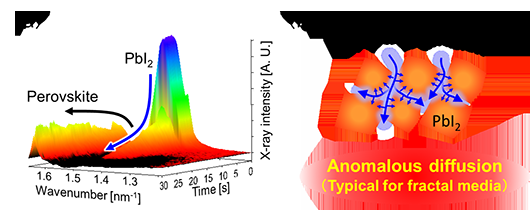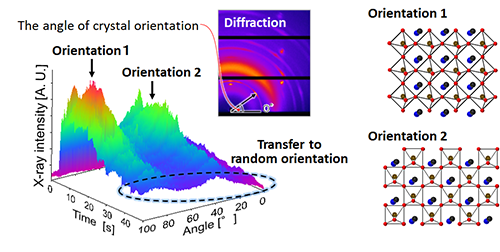Real-time analysis of the formation process of the power-generating layer in organolead perovskite solar cells

Tetsuhiko Miyadera and collaborators have analyzed the fabrication process of organolead perovskite solar cells by X-ray diffraction using SPring-8 large synchrotron radiation facility and have elucidated the formation process of the power-generating layer.
Organolead perovskite solar cells are expected to be highly efficient and inexpensive, and competition in the research and development of these solar cells is accelerating. However, many problems exist in their fabrication process, including the difficulty of fabricating highly efficient solar cells with good reproducibility. In this study, the researchers used an X-ray diffraction method to observe, in real-time with a detecting speed of 10 frames per second, the formation process of the power-generating layer as it was formed during manufacturing; anomalous diffusion and other phenomena were discovered for the first time. Structural analysis of the power-generating layer and development of a device-fabrication process conducted in a complementary manner based on the knowledge obtained in this study on the formation process of the power-generating layer are expected to help further accelerate the research and development of organolead perovskite solar cells. Details of this study will be published online in an American academic journal, Nano Letters, on August 3, 2015.
Research and development of organolead perovskite solar cells have been actively pursued since the achievement of a conversion efficiency of more than 15 % was reported in 2013. Nowadays, a conversion efficiency of more than 20 % is reported. Although, on the one hand, organolead perovskite solar cells are expected to be highly efficient and inexpensive, the difficulty of fabricating highly efficient solar cells in a highly reproducible manner is becoming a problem.
Although elucidation of the mechanisms of formation of the power-generating layer during manufacture is thought to be crucial in realizing high efficiency with good reproducibility, the research until now has not been done under real-time observation with sufficient speed. Therefore, our understanding of the formation process of the power-generating layer is insufficient.

AIST is engaged in the research and development of highly efficient and low-cost solar cells. It has been conducting research on organolead perovskite solar cells and the span of the research ranges from basic studies of the formation mechanisms of the power-generating layer all the way to device development. In the present study, BL46XU beamline of SPring-8 large synchrotron radiation facility was used to conduct 10 frames per second real-time observation of the X-ray diffraction pattern by using the X-ray synchrotron radiation to elucidate the formation mechanisms of the power-generating layer.
Part of this research was supported by a PRESTO program of the Japan Science and Technology Agency; this program is one of the agency's Strategic Basic Research Programs and is titled "Heteroepitaxy for the achievement of high efficiency organic-single-crystal solar cells" (from October 2011 to March 2015).
In organolead perovskite solar cells, the power-generating layer has a perovskite crystal structure and is formed by mixing a lead halide such as lead iodide (PbI2) and a halogenated organic amine such as methylamineiodide (CH3NH3I). Figure 1 schematically shows the molecular and crystal structure of each material.
In the present study, a PbI2 thin film was placed in the X-ray synchrotron radiation beamline of SPring-8 large synchrotron radiation facility. Then a CH3NH3I solution was dropped onto the PbI2 thin film and the formation process of the perovskite crystals was observed by using the X-ray diffraction method. An X-ray 2D detector was used to obtain data, at a speed of 10 frames per second, on the X-rays diffracted by the sample, and the dynamics of crystal formation were then analyzed.

The measurement result in Fig. 2 shows the reduction in the amount of PbI2 raw material over time and the formation process of the perovskite crystal. Analysis of the rate of progression of this reaction revealed that reaction progression did not follow the normal diffusion phenomenon but instead followed an anomalous diffusion process. This is thought to be because when CH3NH3I diffuses into the PbI2 thin film medium, the CH3NH3I diffuses by branching, reflecting the heterogeneity of the medium.
The angles of the X-ray diffraction patterns were also analyzed (Fig. 3). In the early stage of the reaction the formed crystals were oriented in two specific directions, but with the progress of time they changed to a random orientation. This finding suggests that the crystals changed continuously during the process of formation of the perovskite crystal.

This is not the only study to have observed and reported on the formation process of the perovskite crystal by using X-ray diffraction. However, in this study, the researchers measured this process with a fast measuring speed of 10 frames per second; the detailed analysis of the reaction speed and crystal orientation was performed, and these resulted in the world's first-ever discovery of unique phenomena such as the anomalous diffusion and the continuous changes in crystal orientation. These behaviors appearing during the crystallization process can be thought to be the cause of the poor reproducibility of perovskite thin film formation. Therefore, obtaining control over these unique phenomena is the key to highly reproducible fabrication of highly efficient solar cells.
The researchers are planning to feed the knowledge obtained in this study back into research on device fabrication to develop a highly reproducible process for fabricating highly efficient solar cells. The X-ray diffraction method using synchrotron radiation has now been proven to be a valid method for analyzing the formation process of the perovskite crystal. Therefore, the researchers will conduct structural analysis and device development in a complementary manner to accelerate the research and development of organolead perovskite solar cells. The researchers are aiming at putting organolead perovskite solar cells to practical use by 2020.
Provided by Advanced Industrial Science and Technology